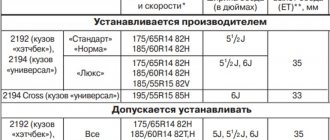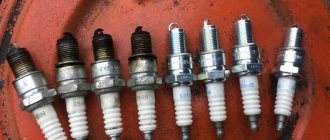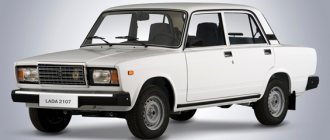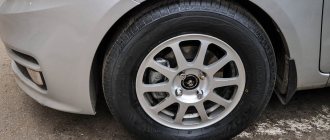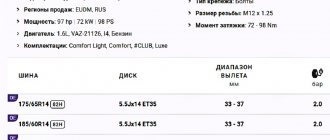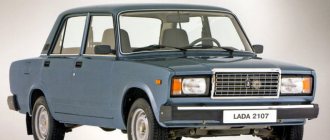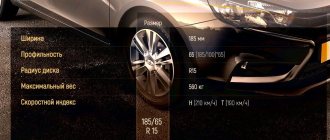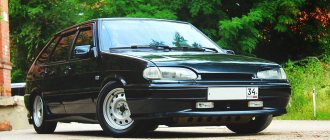18.09.2019
| (Votes: 1, Rating: 5) |
Issues discussed in the material:
- What types of car wheels are there?
- What do the different symbols on car rims mean?
- How to choose the right wheels for your car
- What brands make good wheels?
Car wheels are an important element of the car, which affects the efficiency, comfort and safety of the trip, and also emphasizes the concept of body design. In order for the wheels to fully cope with their functions, you need to take a responsible approach to the choice of wheel rims. What criteria should be followed when purchasing them? In this article you will find useful information and qualified recommendations that will allow you to find the right answer to the question of how to choose wheels for your car.
Disc markings: what letters and numbers say
To figure out how to choose the right wheels for your car, you should study the features of the full labeling of such products. Having understood this issue, the car owner can analyze the information presented in the car’s operating manual or find the characteristics of rims for his car on specialized websites.
In this case, there is a choice between installing a standard disk with strict adherence to the parameters specified by the car manufacturer, and selecting products whose characteristics differ from the basic ones, but are within a certain acceptable range.
In the latter case, only the bolt pattern and drilling parameters remain stable, while other characteristics can vary within certain limits. For example, many crossover owners express dissatisfaction with rims for wheels with a radius of 17 with tires of 45 profile, installed by automakers as standard. Many people report dissatisfaction when driving on such wheels on mud or snowy roads.
Instead of such products, you can choose 16-piece discs with a profile of up to 55 mm. This solution will improve the car’s handling, since in this case the side surfaces of the tires will “work” together with the main tread while the car is moving.
The characteristics of rims for car wheels are determined by the marking (abbreviation), which is the same for products from any global manufacturer. Deciphering such an abbreviation does not take much time.
It is also worth noting that this marking is standard for rims installed not only on cars, but also on any other type of vehicle. Let's look at decoding the markings using the example of 7.5 J x 16 H2 4x98 ET45 d54.1 disks. These symbols indicate the following characteristics:
1. Rim width.
This characteristic is indicated by the first number - 7.5 (the distance between the inner edges of the disc rim in inches). For different tires, this parameter can be in a strictly defined range, so for a specific tire it is better to choose wheels with a rim width that is approximately in the middle part of this range.
2. Rim edge type.
The appearance of the rim edge in our example is indicated by the symbol J, which denotes the shape of the “flange” (where the rim meets the tire). Other combinations of symbols may also appear in disc markings: JJ, JK, K, B, D, P.
It is impossible to say exactly what shape of the rim flange each individual symbol defines. The fact is that in European standards it is difficult to find an unambiguous description of different combinations of symbols. Each individual letter can indicate the shape or radius of the rim edge, and sometimes the angle of the rim flanges.
It is worth paying attention to the most frequently encountered designations. Thus, the combination of letters JJ is used to mark disks installed on the wheels of SUVs. For Jaguar cars you need to select wheels with the symbol P, and for Volkswagen Beetle with the letter B. On trucks, wheels with the symbols E, F, G and H are installed.
3. Rim detachability.
To designate discs with a solid (non-separable) rim, the symbol X is used. If there is a “-” symbol on the marking, this indicates that the product is assembled from several parts and must be disassembled.
The advantage of one-piece rims is their more rigid design. In addition, elastic tires can be mounted on such rims. For hard tires that are used on trucks, you need to select split rims, since such tires cannot be installed on a solid rim.
4. Mounting diameter.
The following numbers (in our case - 16) indicate the mounting diameter of the wheel rim, which corresponds to the mounting size of the tire. In this case, the edge of the disc rim is not taken into account. The mounting diameter is indicated in standard values from 10 to 19 inches.
We recommend
“Alloy wheels wholesale and retail: selection rules” More details
5. Ring lugs (rolls).
The H2 symbol indicates that the design of the wheel rim has bumps on both sides, providing a more reliable fixation of tubeless tires. Even if there is lateral pressure on the tire, no air will escape.
If only the H symbol is present in the marking, then the hump is present on only one side of the rim. If necessary, you can select wheels with the following designations:
- FH – flat hump;
- AH – asymmetric protrusions on the rim flanges;
- CH – combined hump;
- SL – wheels without humps (the tire is held by the edges of the rim).
6. Location of holes for fasteners.
The location of the mounting holes in our example is indicated by the symbol 4x98 (4 holes for fastening, located on a circle with a diameter of 98 with the center coinciding with the center of the disk itself). Most often, there are from 4 to 6 mounting holes, but you can also choose disks that are attached at 3, 8 or 10 points.
The standard diameter of the circle on which the mounting holes are located ranges from 98 to 139.7 mm.
To choose the right wheel rim, you need to know exactly how the mounting holes are located. Inexperienced motorists often make the mistake of determining “by eye” the ratio of the dimensions of the hub and wheel disk.
As a result, after installing the model, for example, installing a 4x98 wheel instead of 4x100, the car owner creates a situation where the car’s wheels will warp and the mounting bolts will unscrew on their own while the car is moving.
7. Disc ejection.
The ET45 symbols determine the distance from the plane passing through the central cross-section of the wheel rim to the plane that passes through the point of contact between the rim and the hub (disc offset).
Types of disc offset:
- With a positive offset, the plane of symmetry of the disk runs further from the center of the car than the mating plane.
- If the offset is negative, then the mating plane will be further away from the center of the car than the plane of symmetry of the disk (in this case, the ET-45 marking is applied to the disk).
- A zero offset value (ET0) indicates that its plane of symmetry coincides with the mating plane.
To choose the right wheel for your car, you should study the recommendations of the car manufacturer. The type of disc offset is indicated in the technical documentation for the car.
8. Bore hole diameter.
In our example, d54.1 is the diameter of the central mounting hole of the disk in mm. The standard value of this indicator for passenger cars is in the range of 50 - 70 mm. It is important to accurately select alloy wheels for the car. The diameter of the central hole of the disk and the size of the hub seating belt must match. If the hole diameter is smaller, it will be impossible to install the wheel.
Availability of humps
The wheel is marked with the letter “H”. It is responsible for the features of the ring protrusions - humps. They hold the tubeless tire on the rims. In most cases, two humpas (H2) are placed on the wheel. If a single hump is used, then its shape is additionally indicated:
- FH – flat;
- AH – asymmetrical;
- CH – combined.
Wheels without humps are only used on some vintage cars that use tubed tires.
It is easy for a novice car owner to get confused in the extensive parameters and technical characteristics of spare parts. Most of them have tables for different brands and models of cars, from which you can find out, for example, the diameter of the hub and the type of bolt pattern. It is important to decide on the preferred type of disk: whether you choose heavy, but inexpensive and reliable stamped disks, or give preference to the stylish, but expensive and fragile “casting”. Both options are widely represented in our catalog - choose new wheels and go!
How to choose wheels for a car
From the fifties until the early nineties, the problem of selecting wheel rims for Russian car enthusiasts was absent. There were several standard versions of such products.
The disk for “Moskvich” had 5 “holes”, and for “Zaporozhets” it had a large central hole. Wheels for VAZ were produced with 4 mounting bolts, for Volga such products had 14 inches, and the overall 16-inch Niva wheel with five mounting holes was sometimes replaced with Volgov's.
Today, the automotive components market offers such a wide selection of rims for car wheels that sometimes even a specialist finds it difficult to choose the right product without a catalog.
Let's take a closer look at how to choose wheels for a car? Which parameters must be observed, and which ones can be slightly modified?
When choosing rims for car wheels, car enthusiasts first of all pay attention to their diameter, width and design. But, first of all, it’s worth finding out whether it will be possible to install specific wheels on a specific car model.
The most important characteristics for selecting rims for car wheels:
- number of mounting holes for studs or bolts;
- the diameter of the circle on which the mounting holes are located;
- diameter of the hole in the center of the disk (DIA);
- wheel rim offset.
Let's take a closer look at all the most important parameters. It must be taken into account that the first and second indicators must strictly comply with the requirements of the car manufacturer. The diameter of the hole in the center of the disk may be slightly larger than the recommended values. To compensate for the difference in diameters, you can buy special rings in auto stores.
The disc offset in the international system is designated ET (from the German word Einpresstiefe). The smaller this parameter, the wider the vehicle's track will be, since the wheel will protrude more beyond the wheel arch. You can also choose wheels with a negative offset.
Offset can be called the most important characteristic of a wheel rim. This indicator has a significant impact on the car's stability on the track and its handling. If the offset is reduced, then, accordingly, wider wheels will increase the load on the steering and wheel bearings.
With a reduced offset, the wheel will be located deeper inside the wheel arch, therefore, when turning, it may touch some body parts, which will lead to damage. To choose the optimal wheel model for your car, you should not deviate from the standard offset by more than 3–5 mm (up or down).
The diameter of the rim of a disc is most often indicated in inches. This parameter must be selected taking into account the tire diameter.
The width of the wheel rim indicates the distance from one flange to the other and is indicated in inches. At the same time, it is worth noting that some car tire manufacturers indicate the tire width in millimeters. The current trend involves increasing the width of wheel rims and tires.
The rim diameter and its width are most often subject to tuning. Car owners, as a rule, want to make these figures higher. In order for a wheel with a larger diameter disc to fit in the wheel arch, you need to select low-profile tires for its configuration, which makes the car even more stylish.
At the same time, you need to remember that there are GOST requirements for matching the size of potholes on Russian highways! According to this document, a pothole up to 50 mm deep with a sharp edge may be present on the road. There are no penalties for such a defect in the road surface. But even such a hole poses a threat to wheels with low-profile tires, which Russian car enthusiasts love so much.
For example, many owners manage to install 18-inch wheels on a Hyundai Solaris instead of standard wheels with a diameter of 15 or 16. In this case, the wheel can be equipped with a 215/35 R18 tire, in which the distance from the rim to the road surface will be only 75 mm. Such rubber will most likely be punctured even if it falls into a hole, which is allowed by road GOST.
There is also an alternative option for completing the car wheels. In this case, car owners strive to select a disk with a minimum diameter (as long as they do not touch the brake caliper while driving), and the required wheel size is “finished” by installing a high-profile tire.
Thanks to this solution, you can save on purchasing tires with a smaller diameter and increase the smoothness of the car's ride. For example, for the same Solaris or Kia Rio you can choose 14-inch wheels with 195/70 R14 tires. As a result, the wheel diameter will be even slightly larger (up to 3%) than in the standard configuration of these models with 185/65 R15 wheels. Cars with such wheels can be compared to Renault Logan in terms of smoothness.
We recommend
“Alloy wheels or stamped ones: all the pros and cons” More
In the same way, different wheel sizes are installed on crossovers. For example, previous modifications of the Nissan X-Trail can be equipped with 16-inch wheels - this car has a wheel of exactly this size, despite the fact that in the basic configuration such cars came first with 17-inch and then 18-inch inch. Sometimes on the X-Trail you can even find wheels with a diameter of 20 inches.
When deciding which wheels to choose for a crossover, you should decide what result you want to get: a car with characteristics similar to an SUV or a large sports car with a rigid suspension. At the same time, you should not lose your sense of proportion - the car’s gearbox will remain the same.
Landing diameter
The bore diameter is the size of the wheel circumference in inches. Depending on the tire size, it can vary by one to three inches. Information about the permissible disc diameter is usually indicated by the manufacturer, and it should be selected according to the make and model of the car. Slight confusion is caused by the designation of the parameter - using the letter “R”, for example R15 or R17 - many people mistake this designation for the radius. This is the diameter!
Larger wheels look cooler, but the larger the wheel size, the greater the load on the suspension parts, reducing the tire profile and reducing its shock-absorbing properties. And smaller wheels may not fit on the brake caliper.
Popular brands of car wheels
Many well-known Russian and global automakers produce wheels at their own factories. The range of such products is formed based on the characteristics, cost and equipment of car models produced at the factories of a particular concern.
At the same time, automakers may recommend rims of certain brands to equip their vehicles. This situation allows us to systematize products manufactured in the disc segment by car brand and create an unofficial rating of products from different brands:
- How to choose the right wheels and tires for a Russian-made car in terms of price/quality ratio? For cars such as GAZ or UAZ, you can choose wheel rims from domestic brands K&K, IFree, SKAD, Trebl, Steger, Arrivo, etc. The assortment of these enterprises includes stamped, cast and a small segment of forged rims, as well as additional accessories for completing wheels (decorative plastic, steel or rubber caps and other products).
- If you need to select wheels for cars of Japanese brands (Toyota, Nissan, Honda, Mazda, Mitsubishi, Suzuki, etc.), instead of standard ones, you can choose alloy wheels from such well-known brands as Vissol, LegeArtis, YST, NZ, Alcasta, Cross Street, Megami .
- For European cars from the budget segment of models (Opel, Renault, Peugeot, etc.), as an alternative, you can choose wheels from Russian manufacturers, since the location of the mounting holes for 4 studs is the same as for VAZ cars. Products from the brands LegeArtis, X-Race, IFree, Yokatta, SCAD, K&K, which belong to the relatively budget segment and are intended for compact cars, are popular among European motorists. At the same time, it should be noted that given the technological complexity of production and the interesting design of discs, these manufacturers cannot saturate the market with cheap products. For example, 14-radius car wheels in their catalogs cost more than 10,000 rubles. per wheel.
- How to choose wheels for a car model that belongs to the premium segment? Owners of prestigious cars, such as Mercedes, BMW, Audi or Porsche, first of all pay attention not to cost, but to design and quality indicators. For such cars, manufacturers offer exclusive rims (often even handmade products), the price of which exceeds 100,000 rubles. per wheel. At the same time, you can choose more affordable products. The most well-known brands that produce wheels for premium cars include Vissol, Replica, LegeArtis, Lexani, Lorenzo, Zito, Niche and other companies that have been working on the market for quite a long time.
- For Chevrolet, Cadillac, Ford, Chrysler, Dodge and other cars of American manufacturers, you can select wheels from the catalogs of such manufacturers as Megami, Alcasta, Yokatta, YST, NZ and other brands that were listed earlier. This is largely due to the fact that cars from the United States are often adapted by manufacturers to European standards.
The best way to select wheels by car make is a virtual selection using special programs that take into account the maximum range of parameters, from wheel diameter to the features of a specific car model.
Sprung and unsprung mass
To better understand the relationship between the weight of a car wheel and its dynamic characteristics, it is necessary to take into account all the forces that act on the vehicle while driving. Experienced engineers and designers at automobile factories always pay attention to one important indicator - the difference between the unsprung and sprung masses of the car.
From the point of view of engineering science, the sprung mass includes all elements and parts of the vehicle that are located between the spring and the body (i.e., separated from the road surface). Conversely, unsprung mass is everything that is located between the road and the car's springs. If you correctly redistribute the proportion of these two indicators, you can increase braking efficiency, improve the smoothness of the ride and increase the dynamic qualities of the car.
We recommend reading: Pros and cons of an automatic transmission
Choosing car wheels: opinions of car enthusiasts
The recommendations given here preserve the spelling features of the writing and punctuation of the authors.
1. “I’ll give you an example from my practice. In winter I drove on 17-piece alloy wheels and after one wheel hit a deep pothole the disk cracked. After this incident, for the winter I change the alloy wheels to regular steel ones with plastic caps.”
2. “You don’t have to worry too much about choosing wheels for your car, go to a specialized store and buy with installation those that you like and are best suited for your car. The store consultant will explain everything and help you make the right choice.”
“I’ll also add about the features of selecting alloy wheels:
- Quite often, the nuts from the original stamped wheels do not fit the alloy wheels (instead of nuts for 21, you have to select nuts for 17 or 19). In this case, you need to buy not only a set of fastening nuts, but also a wrench.
- There are cases when the stamped nuts fit the cast ones in size, but the wheel wrench itself does not fit into the disc. When selecting wheels, you need to check whether your key fits them, so as not to encounter this problem if you need to replace the wheel on the road.
- It is possible that only a nut (or bolt) for an internal hexagon can be installed in new alloy wheels. In this case, standard fasteners will not help. You will have to select nuts and a hexagon (you can use an adapter for the original “balloon”).
To select alloy wheels, you need to carefully measure everything (fasteners, wheel wrench, etc.). Otherwise, you can buy new tires and calmly wait for the seasonal replacement of tires, and then find out that you urgently need to look for a key and fasteners.”
3. “When selecting alloy wheels, you should pay attention to one more feature. It is better to buy models with wheel “spokes” that go from the center to the edge of the wheel rim. Such discs are able to withstand stronger impacts, which is important on our roads with a lot of potholes.”
We recommend
“How to properly store and care for disks” More details
4. “I always select alloy wheels so that the tire and disk are completely without installing different cone bolts. This is not difficult to achieve, since there is a wide selection of different models on sale. I’ve already learned how to select wheels even on Avito - delivery there is free (if it’s especially bad, you can wait a few days).”
5. “If you decide to choose wheels from a well-known brand (for example, Brembo), then in its online catalog you can find product labeling for a specific car brand. I dare to try on strange wheels for my car, and even more so, buying something unknown is risky. You need to be especially careful when selecting ventilated wheels with notched holes (drilled - slotted). If you want to install 2-4-6 piston brakes, the brake disc can be selected as a kit (preferably from a reliable brand), but it is better to use the original one.”
Smooth ride
Calculations show that reducing the weight of each wheel by at least one kilogram is equivalent to reducing the weight in the cabin by 40 kilograms. In practice, we can give the following example: if you reduce the weight of each wheel by four kilograms (this is not difficult to do, considering how much one forged rim weighs), then the smoothness of the ride will be the same as if you had four passengers in the cabin. Overclocking characteristics will remain at the same level.
The answer to the question “Which wheels are lighter, forged or cast?” everyone knows. For example, one original 20-inch cast rim for Range Rover weighs about 25 kilograms. A forged analogue with a maximum static load for the same car is about 13 kilograms. Each wheel is approximately 12 kg lighter. As a result, forged wheels make it possible to reduce unsprung weight by almost half a ton, and improved ride smoothness is achieved without loss of dynamics and acceleration characteristics.
When you should not use cast rims for cars
In general, they can be used in all situations. The only thing is, if the rim size is not suitable for a particular car, then you should not install it. Among the advantages of using them are minimal weight, as well as the ability to abandon the constant use of caps, which are endlessly lost. In addition, light alloy cast rims have an attractive aesthetic appearance and can serve as car decoration.
At the purchasing stage, you need to look at what markings are applied to certain rims and if questions arise, then in such a situation it makes sense to contact the seller to provide them with advice. If you often drive outside of paved roads, then you should not give preference to alloy wheels, since this choice will not be justified.
If you have chosen them, then in this case you should drive through railway intersections and other obstacles as carefully as possible, even if you are sure that the manufacturer used high-quality raw materials.
Tuning stamping
One of the options for improving the appearance of stamping is to paint the stamped discs yourself.
Painting stampings requires the presence of:
- spray gun;
- compressor;
- paints;
- solvent;
- sandpaper.
Painting stampings always begins with diagnostics. Discs with a diameter of 13, 14, 16 and others should not be damaged or dirty. They are processed with sandpaper, thoroughly washed, dried and degreased.
First, a primer is applied in 2-3 layers, which, after it dries, must be sanded with sandpaper. The next step is painting the stampings. Using a spray gun, apply 2-3 layers of paint; acrylic is best suited for this. After this, the stamping can be varnished.
Chrome stampings are also in great demand among car owners. This protective and decorative coating is quite expensive.
Useful! Chrome plated discs have good protective properties if the layer thickness is from 20 to 50 microns. A thinner layer will not protect against corrosion.
Chrome stampings can be made using a wear-resistant or decorative type of chrome plating.
In the first case, hard chrome is applied to the steel. The coating thickness is 10-300 microns, which makes chrome wheels harder and more wear-resistant.
In the second case, a layer of nickel is applied to the steel, then a layer of copper, the next layer is semi-shiny nickel, then shiny nickel and, finally, a layer of transparent chrome, which protects the nickel from tarnishing. Particular attention is paid to polishing - this is a long and labor-intensive process. Chrome stampings give the car uniqueness and presentability.
What to choose?
If you live in a city and travel exclusively on good roads, but do not want to spend extra money, alloy wheels are the best option. Moreover, the car market today offers many high-quality models at an affordable price, the best of which are products from European, Russian and South Korean production, and the worst, respectively, from China and Turkey.
Those who love speed and are unable to drive otherwise should take a closer look at forged wheels, which have greater strength and less weight. In addition, these products are adored by tuning connoisseurs and people with high incomes.
As for stamped steel wheels, they are often chosen for driving on roads with poor surfaces, are used as a replacement for cast models in the winter, and are also used to equip workhorse cars. These discs are inexpensive and allow you to make repairs without outside help, even in the field.
Brief comparison of the weight of the main types of rims
- Steel - made using stamping technology - is the heaviest and most losing option. Many car owners prefer to change such wheels to lighter ones immediately after purchasing a car. The only advantage of this category is its reasonable price.
- Cast aluminum - provide weight savings of approximately 20% compared to steel counterparts. In addition, they have a beneficial effect on the cooling of the brake system and are easy to process, which simplifies repairs and allows the use of unique design solutions for custom manufacturing.
- Forged - provide minimal weight. A special technology for the production of forged wheels (hot stamping method) makes it possible to reduce weight by 20–50% compared to analogues made of aluminum and steel, respectively. And due to its unsurpassed ductility (if there is a strong impact, the rim does not burst, but is only slightly deformed), reliability increases. Even though forged wheels are more expensive than their cast or steel counterparts, the increased dynamic performance, improved braking performance and maximum safety are worth the expense.
MAX LOAD
There is one more additional parameter that has nothing to do with the size of the disk, but it is important for the correct selection of the disk. This parameter is called MAX LOAD - maximum load on the disk. For passenger cars, rims are usually made with a safety margin, but if rims for a passenger car are placed on a jeep or minibus, they may not withstand the load and become deformed if they fall into even a minor hole. Therefore, when choosing wheels for a jeep or other heavy vehicle, be sure to pay attention to the recommended maximum load on the disk. MAX LOAD is measured in pounds or kilograms. To convert pounds to kilograms, you need to divide them by a factor of 2.2
.
For example, if the specified load is 2000
lbs (2000LB) then:
MAX LOAD = 2000LB = 2000 / 2.2 = 908 kg
